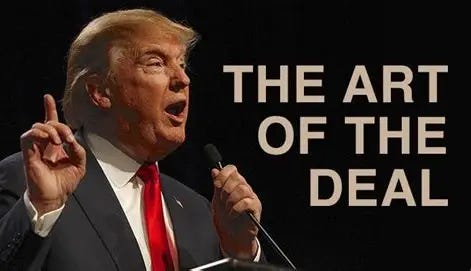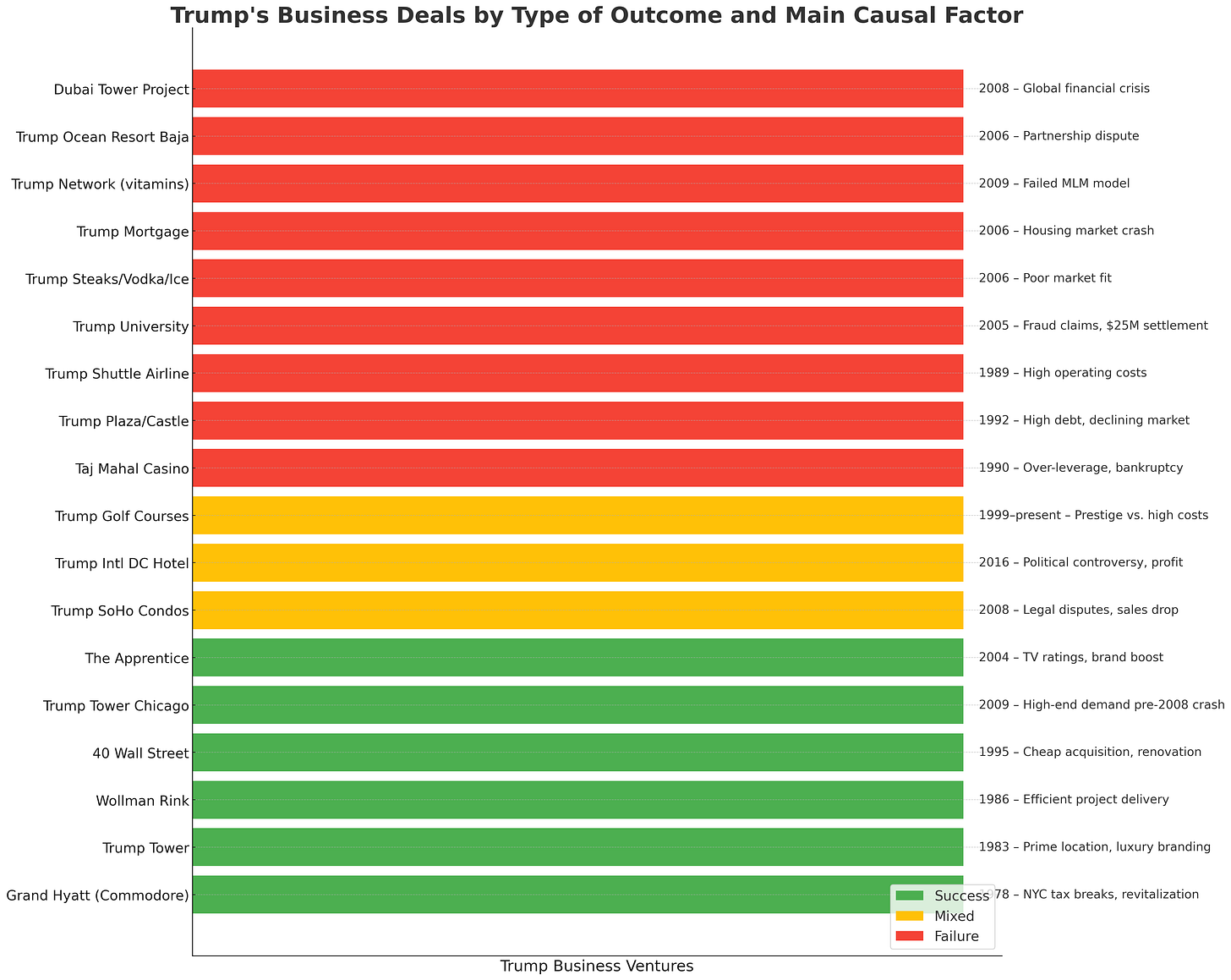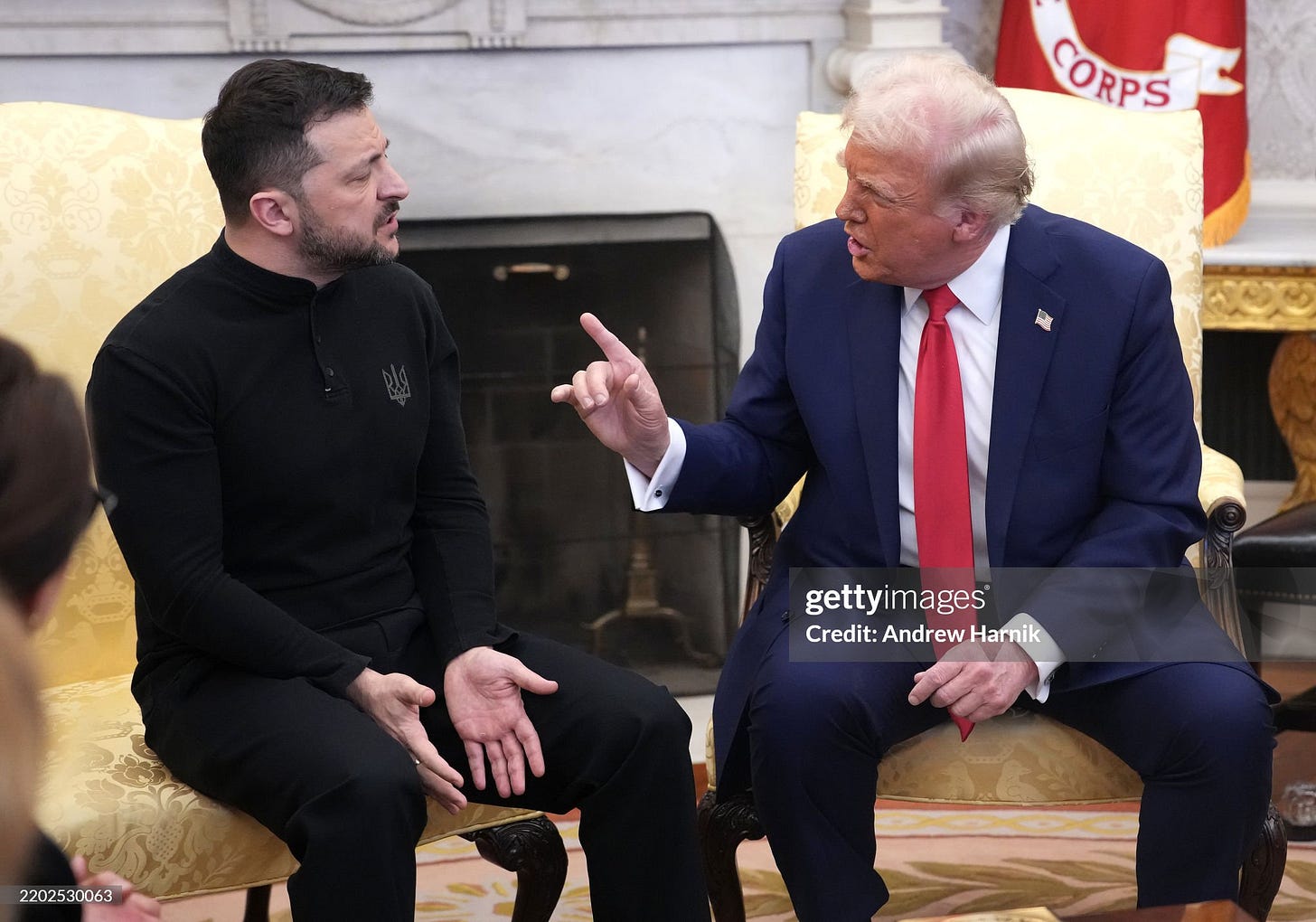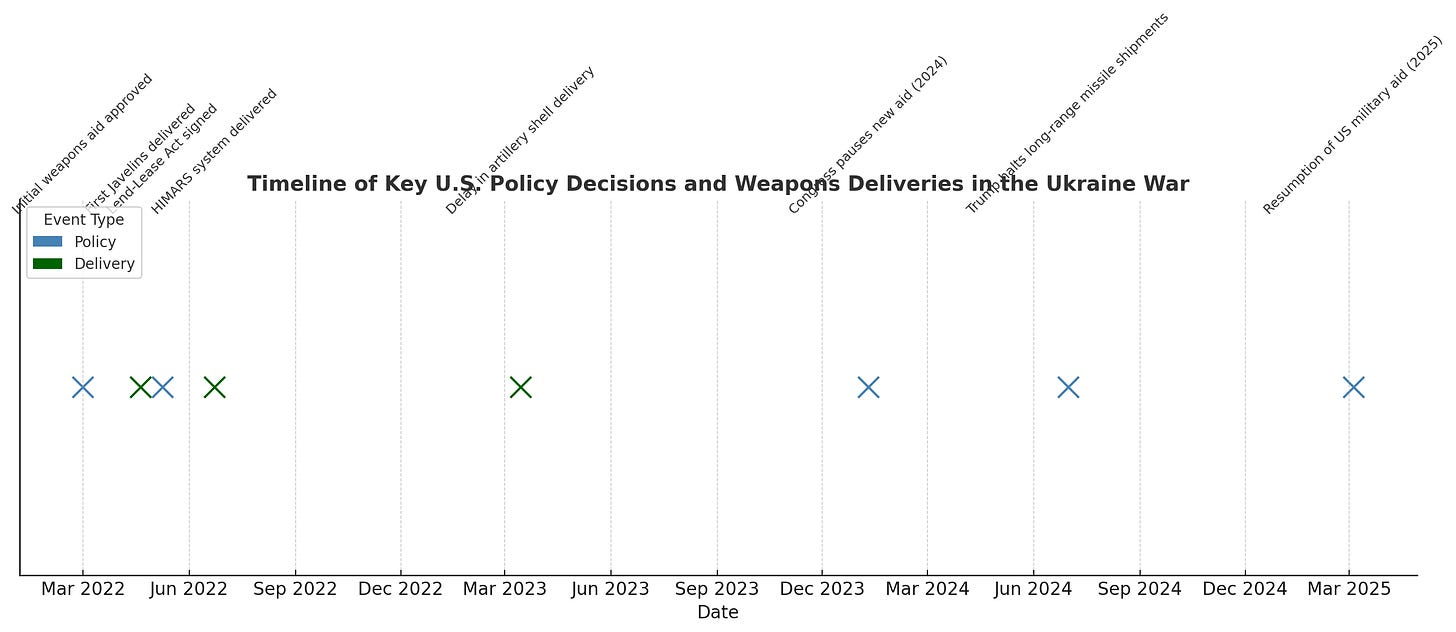Contains some edits of the original
Dear Friends,
As is well-known, during his career as a property developer Donald Trump published a book in 1987 called ‘The Art of the Deal,’ (which we call ‘AOD’ throughout this letter). This was ghost-written by a journalist, Tony Schwartz, who stayed close to Trump, sitting in on his phone calls for several months.
The book was extensively publicized by Trump such that it became a national best seller. The first season of the show ‘The Apprentice” in 2004 opens with Trump in the back of a limousine saying: “I’ve mastered the art of the deal, and I’ve turned the name Trump into the highest-quality brand.” Tony Schwarz said in an interview when Trump announced his election campaign many years later, “more than anyone else I have ever met, Trump has the ability to convince himself that whatever he is saying at any given moment is true, or sort of true, or at least ought to be true.” (New Yorker, June 19, 2017, Mayer).” Trump was elected in the widespread belief that his apparent business acumen would work to solve the supposed deep problems that he told us we were facing in the US – the swamp, the deep state, illegal immigration, exploitation by other countries, and economic stagnation. (Check out my letter of July 13 - the truth about the Biden economy).
In today’s letter I am looking at Trump deal-making in a new setting - international conflict resolution. Of course, this is an extremely broad subject that has been written about by many, so as usual I can only provide an ‘aide-memoire.’ Also, as usual, there is a lot of data here that I cannot guarantee is all completely correct, but I believe in the basic story.
The Business Deals
First of all, let’s look briefly at Trump’s business dealmaking. In ‘Art of The Deal’ Schwartz codified what he understood as Trump’s principles based on a creative interpretation of Trump’s property dealmaking practice.
Think Big. This meant being ambitious in terms of investments as broad concepts as well as specific projects.
Use Leverage and Bluff. This meant the use of media to create the perception of value as much as the reality.
Get the Word Out meant aggressive use of media and control of narrative to build a global, personal, brand.
Protect the Downside to reduce risks, avoiding over-leveraging and making realistic projections.
Fight Back Aggressively could be effective in the short term to win favorable deal terms.
Maximize Options and Flexibility. This meant optimization under uncertainty which was good practice subject to maintaining commitment and positions.
Deliver the Goods. This meant to create true value for the stakeholders by completing projects on-the-ground.
These categories could be inconsistent with each other but somehow were usable in specific cases. Critics (e.g. Schwartz himself, or The Nation, Ganz, April 7) stated that in AOD personal branding objectives often took precedence over substantive achievement (delivery). The negotiating environment assumed was zero-sum, not win-win, and the branding strategy worked better in private real estate transactions but was likely irrelevant in public diplomacy or between teams.
Which of trump's main business deals were successful and which failed?
The following chart sets out twenty or so of Trump’s main commercial investments or investment types, and a main causal factor for their success or failure.
Trump’s best deals often involved branding/licensing, fortunate timing during downturns, and media leverage. Failures were often due to financial over-leverage, lack of management depth, or misjudging markets. His business model was often less about long-term effectiveness and more about publicity, short-term wins, and brand extraction. All in all, the success rate for Trump’s main business deals was less than 50%. Among the most lucrative were the Apprentice (2004–2015) TV reality show, where according to Business Insider (Sep 29, 2020) he earned over $400 million from the show, licensing, endorsements, and related deals. On the other hand the Atlantic City casinos were financially disastrous with multiple bankruptcies, including well over $1 billion in losses. (New Yorker, Cassidy, May 10th 2019). One indicator, if not entirely comparable, was that his new starts performed possibly worse than the US average for new start businesses, 20% failure within the first two years, 45% within five years and 65% within ten. (Sources: Admin Office of the US Courts; American Bankruptcy Institute).
The Peace and Conflict Resolution Deals
From 2016 on taking the Presidency Trump’s business deals were superseded by ‘political’ deal-making, including conflict resolution. His peace-maker role, like his business initiatives, has been controversial. While by far the major one has been Ukraine for which he made a specific undertaking during the election, some others have also been very significant. The illustrations below are highly abbreviated in the space of a letter, but I think reflect reasonably the essence of what happened.
North Korea. The Trump–Kim Jong-Un Summits basically failed. Obama had briefed him specifically on the urgency of a N. Korea agreement but Trump, sidestepping the history of the conflict which was still unresolved after 70 years, treated the discussions as though they were a transaction resolvable using personal diplomacy and political theater. E.g. Peace with North Korea was declared after one summit with photo ops at the DMZ. Three meetings resulted in merely a temporary freeze on nuclear/missile tests. There was no framework for verification or enforcement, or technical follow-up. North Korea resumed missile testing, rejecting further talks later under Biden. (Sources: Carnegie Endowment, CSIS, CNN, UN Nuclear Watch)
Afghanistan and Taliban. Under the Doha Agreement of 2020 the Taliban agreed not to harbor terrorists and released 1,000 Afghan soldiers while the Afghan Government were required, against their judgment, to free 5,000 Taliban prisoners, while the US pledged troop withdrawal by May 2021. A critical error was the exclusion of the Government from the talks with the Taliban as a result of Trump deciding to use his personal negotiation skills, trusting that ‘words are bonds.’ The Afghan forces and Government folded quickly (partly because of being excluded from the Agreement), the Taliban overran Kabul and forced a rushed evacuation which resulted in deaths of US troops, since blamed by the Republicans squarely on Biden, ignoring the flawed negotiations and the flawed provisions of the agreement. (U.S. Special Inspector General for Afghanistan Reconstruction, The Atlantic).
Serbia–Kosovo Economic Agreement. Trump hosted leaders in DC for an Agreement on infrastructure and energy to boost his image as peacemaker. Despite progress on the economic projects however, tensions rose again in 2023–2024 and the EU has intervened. (European Council on Foreign Relations, Al Jazeera, Euronews)
Sudan–Israel Normalization resulted in the removal of Sudan from the U.S. list of State Sponsors of Terrorism. Trump in this case linked normalization to lifting sanctions and financial aid. However, civil war restarted in 2023 and normalization was not implemented. (UN Crisis Group, U.S. State Dept).
India–Pakistan. The tension over Kashmir in North India had been going on since the partition of India in 1947. Trump treated it as a simple peace treaty exercise and offered to mediate in 2019, claiming that Modi had requested U.S. help. This was emphatically denied by the Government who stated that it was an internal bilateral problem. No talks were initiated; India rejected third-party mediation.
Venezuela. Trump recognized opposition leader Juan Guaidó as interim president (2019); and imposed heavy sanctions on the Maduro regime. However Maduro remained in power and U.S. efforts did not lead to regime change. The initiative as usual seemed to involve a lack of understanding of history, inadequate regional coordination, and sanctions which hardened opposition.
Yemen Civil War. Trump supported a Saudi-led coalition and vetoed a congressional resolution to end U.S. arms sales to Saudi Arabia. The conflict continued and the humanitarian crisis worsened. The U.S. prioritized the alliance with Saudi Arabia over mediation and genuine peace making.
Iran. Trump withdrew in 2018 from the carefully formulated 2015 Iran Nuclear Deal put together by an international group including the US under Obama. “The Iran Deal was one of the worst and most one-sided transactions the United States has ever entered into”, said Trump who imposed “maximum pressure” sanctions on Iran. These had little effect and Iran resumed uranium enrichment; U.S.-Iran tensions escalated. The bull-in-a-china-shop US approach as usual alienated allies; no realistic alternative diplomatic path forward was created, and in 2025 a conflict began with Israel which pulled in the US, where Trump without reference to Congress sent stealth bombers to assist Israel in destroying the Iranian nuclear infrastructure. The results of this adventure are not known but it ensured that grounds for US mediation role were ruled out.
Gaza and Palestine. A potential major success for Trump, negotiated by his son-in-law Jared, was the ‘Abraham Accords.’ This initiative saw the UAE and Bahrain normalize relations with Israel, with Morocco and Sudan entering agreements on trade, flights, and recognition, mediated by the U.S. The accords were adopted by Biden. However, this apparent success obscured a critical weakness on the status of the Palestinians. The US side again appeared to be unable to understand the seriousness of history, treating the agreement again as a largely business-related ‘deal’ which would supersede the Palestinian issue. On October 7, 2023 this failure was a factor in the attacks on Israel from Gaza. (Brookings, Reuters, Council on Foreign Relations). This upset was made more difficult by the steps taken during Trump 1.0 which effectively ruled out the US as a mediator - recognizing Jerusalem as Israel’s capital, moving the U.S. embassy there, cutting U.S. aid to the Palestinian Authority, and withdrawing from UNRWA because it was supposedly staffed by Hamas supporters. In 2020 a premature and arrogantly optimistic “Peace to Prosperity” plan had proposed a demilitarized Palestinian state with heavy Israeli control, far away removed from the Oslo Accords brokered by Bill Clinton which were the basis for a two-state solution.
While the AOD categories optimistically formulated by Schwartz, if applied, might have improved the deal record they were to a large extent not complied with, particularly in the case of the Abraham Accords or in other areas where photo ops and political theater replaced genuine delivery. The objective seems to have been as much about getting the Nobel peace prize as getting the peace.
The Story of the Ukraine-Russia ‘deal’.
The Russia-Ukraine crisis is an exceptional case not only because of missteps in diplomacy but also because of its huge implications for the World which has relied up to now on US diplomatic efforts but can no longer. (See newsletter of March 2 and 22). There were initial mistakes by the Biden Administration in its excessive caution in the provision and allowable use of arms supplied to Ukraine. However that issue had been largely resolved by the time of Trump’s second assumption of the Presidency. A policy of attrition, making it increasingly and excessively expensive for the Russians to maintain their attacks, was then effectively in place, which was the only one likely to succeed given the objectives of the two sides. Now that option is probably lost.
Over 2017 to 2021 Trump’s approach to Russia, likely for reasons of his personal history and contacts in that country, was accommodating while his attitude to Ukraine was at the same time surprisingly hostile, e.g. when in 2019 he pressured the new president, Zelensky, to prosecute Biden’s son in return for the release of an agreed weapons package for Ukraine’s defense. In 2022 Russia mounted its invasion. (See newsletter of March 22).
In 2024, running again for President, Trump stated, “If I'm president, I will have that war settled in one day, 24 hours," an impossible promise, like so many others, which nevertheless helped him get elected. On his reentry to the White House Trump put on hold dealings with Ukraine including the desperately needed supply of arms.
Trump informed Zelensky in February 2025 at Mara-a-Lago that: "You (Zelenskyy) should have never started it. You could have made a deal," parroting the disinformation put out by Putin and the Russian media. Military aid was recently resumed under pressure, damaging confidence in U.S. reliability (Institute For Peace, Jan 23, Carment et al).
Mediation attempts have been conducted on and off over the past six months but Putin has essentially repudiated US efforts and shown contempt for the US Administration’s apparent inability to comprehend the dynamics of the Ukraine situation, a problem which has also severely frustrated Zelensky. (See newsletter of May 28).
Trump did not maximize his options, instead cutting the ground from under his own feet by showing his hand prematurely and relying on the word of Putin, an assumed ‘personal friend.’ There was a failure to understand either Putin’s imperial aims vis-a-vis the former Soviet States, as set out in his essay “On the Historical Unity of Russians and Ukrainians,” published just before the invasion (see newsletter of May 15) or his tactics which stem from his deep cold-war KGB origins as a case officer in East Germany.
The visits (latest 6th August) of Trump’s Representative Steve Witkoff to Moscow undermined any use of leverage with Putin while putting Ukraine itself under extreme leverage. In terms of thinking big Trump also failed this test because he and his advisers did not seem to recognize the history and the scale of the problem but brushed it aside as a regionally based dispute. As a result, he did not deliver the goods that he had promised in terms of agreements and peace but instead drew global disdain for America as a broker in the crisis. Now, 200 days after his resumption of the presidency, Trump has asked for a face-to-face meeting with Putin alongside Zelensky. Whether this actually occurs it is extremely unlikely to achieve more than further delay – to the advantage of Putin, because the critical ingredients of a peace treaty don’t exist. That is, Ukraine will not surrender its four Eastern Provinces along with its military status, its sovereignty and its future as a European nation after years of destruction by its ‘friendly Slavic neighbor.’ (London Times View, Harnik, Aug 1),
Donald Trump’s deal-making criteria derived from the AOD when applied to Ukraine–Russia has not translated into meaningful conflict resolution, because he focused on one-sided transactional gains rather than structural peacebuilding. His deal style failed to solve deep-rooted issues where legitimacy, trust, and balance were essential. Without a clear strategy, consistent support, or a committed deterrence plan, America has simply extended the war. (Modern War Institute, Metcalf, Jan 9). Here are Trump’s negotiating positions in the context of the main categories of the AOD.
Used Leverage. Lost leverage through laying out US bargaining positions with Russia in advance on the ill-judged basis of assumed personal friendship with main counterparty.
Bold Vision. None – Without overarching understanding of dynamics at play Trump supported Russian claims, initially treated Ukraine as the aggressor based on Russian disinformation, seriously undermining chances of a peace breakthrough.
Flexible Options. None - lack of any alternative beyond personal appeals to Putin after revealing potential bargaining positions. Undermined multilateralism and ceded responsibility to Europe.
Getting the Story Out. Negative - Extensive Russian disinformation initially encouraged the US to wrongly stigmatize Ukraine.
Tangible Delivery. No change in status quo has been achieved after the Russian invasion apart from gradual Russian advance resulting from delay in weapons shipments, or due to complicated supply arrangements through Europe.
How far have the ‘Strategies’ of the AOD Helped in Solving Existential Crises?
The AOD strategies, written down by Schwartz from his interpretation of general statements by Trump, were not necessarily wrong in principle but they have largely failed in practice. Trump’s deal-making strategies have been moderately effective when the goal was narrow and transactional, there were clear, immediate incentives, and the deal did not require long-term gestation and trust. They have failed when applied to complex peace processes such as Ukraine, North Korea, Afghanistan, and Palestine, burdened by historic conflicts and structural problems. Complex diplomacy needs to generate trust, respect history, multilateral norms, and domestic politics of multiple actors, as in the Oslo Accords under Clinton or the Iran Nuclear deal under Obama, or the Reopening of relations with China under Nixon.
As we enter a week of new Ukraine negotiations the signs are poor that the US has disengaged from the Putin version of history and the terrible destruction in Ukraine remains a stain on the US world role. Let’s try to make our voices heard!
Best wishes to all and please comment!
David







